The Kenopaniṣat-Svāminārāyaṇabhāṣya (henceforth, KSB) provides a reading of the Kenopaniṣad in light of the principles of the Akṣara-Puruṣottama Darśana advocated by Bhagavān Svāminārāyaṇa. In doing so, it presents numerous both interpretive and darśanic insights on the revelations of the Kenopaniṣad. This short work will highlight only a few of these contributions as they pertain to two trajectories or perspectives by which the Upaniṣad is analyzed. The first perspective from which this work will investigate the KSB’s noteworthy contributions to darśanic thought will be from a linguistic and literary trajectory. Discussion from this point of view will highlight commentarial elaborations on significant grammatical expositions, stylistic elements, and referential methods. Following thereafter is an analysis of the commentary’s important darśanic expositions. For self-evident reasons, this latter investigation is presented under the darśanic trajectory section of this work. Although there are many notable characteristics within each trajectory, this work will focus on presenting only a few.

Significant Expositions from
the Kenopaniṣat-Svāminārāyaṇa-bhāṣya
by Sadhu Aksharananddas
Linguistic and Literary Trajectory
Viewed from a linguistic and literary trajectory, the KSB presents several noteworthy expositions. This work presents discussions on these elaborations as they pertain to the following three major categories: discussions pertaining to (1) grammatical elaborations, (2) literary style, and (3) referential methods.
Although the KSB is a Vedānta work, it presents numerous grammatical elaborations at different points in its exposition. Among these elaborations, it provides a grammatical basis of some of the terms found within the base text. For instance, its exposition of ‘iṣitam’ from the first mantra (aphorism) states: “iṣataṃ chāndasoyaऽmaḍāgamaḥ.”1 Later in its elaboration of ‘amahīyanta’ the commentary clarifies the base root from which the term is derived along with its associated meaning: “mahīṅ pūjāyām.”2 The KSB also provides clarification on the pratyaya (suffix) affixed to generate a term and its affiliate meaning. For example, its elaboration of ‘nyamīmiṣad’ in Kena. 4.4 explains: “nyamīmiṣad svārthe ṇic.”3 The same analysis is also provided later in the term’s reappearance in Kena. 4.5.4
In addition to providing analyses of word generations, the commentary is also forthright in specifying when the base text deviates from Pāṇinian grammatical norms. Aware of the missing visarga after ‘vidma,’ it meticulously states: “visargalopaśchāndasaḥ.”5 The commentary also identifies variation in case (vibhakti or kāraka). With regards to the nominative case of ‘yuṣmat’ used in Kena. 2.1, it clarifies: “tvaṃ tvayītyarthaḥ । chāndasatvāt saptamyarthe prathamā ।”6 The KSB is even conscientious in identifying variations in gender (liṅga). For example, the commentary of ‘prathamaḥ’ of Kena. 4.2 states: “prathamaḥ prathamam । chāndaso liṅgavyatyayaḥ ।”7 Variations in number (vacana) are also identified and clarified within the commentary. For instance, the deviation of the number of ‘vidāñcakāraḥ’ of Kena. 4.2 is explained by the commentary by: “vidāñcakrurjñātavanta ityarthaḥ । vacanavyatyayaśchāndasaḥ ।”8 Similarly, the commentary of Kena. 4.4’s ‘vidyuto vyadyutad’ explains the departure of number with: “chāndaso vacanavyatyataḥ।”9 Noteworthy among all of these expositions is that the commentary never states that the base text is incorrect. Instead, it takes a reverential approach by identifying such variances as chāndasa-prayoga—a distinctive Vedic usage.
The KSB also uses grammatical analysis to present innovative and hermeneutically instructive descriptions of well-known terms. The commentary discussion of ‘Upaniṣad’ and ‘Vedānta’ in its exposition of Kena. 4.7 provides a broad survey of the content of the Upaniṣads and the interests of the Vedānta darśana by offering an analysis of their grammatical components. It deconstructs ‘Upaniṣad’ by stating: “ma upaniṣadaṃ brūhi upa + ni ityupasargadvayapūrvakaṣadlṛdhātoḥ kvipi siddhoऽyamupaniṣacchabdaḥ ।”10 It then connects this analysis with brahmavidyā: “tathā copaniṣadyate prāpyate jñāyate brahmavidyāऽnayetyupaniṣacchabdārthaḥ ।”11 Thereafter, the commentary cites the Muṇḍakopaniṣad aphorism: “yenāऽkṣaraṃ puruṣaṃ veda satyaṃ provāca tāṃ tattvato brahmavidyām । (Mu. 1.2.13)”, to offer an exposition of brahmavidyā. By identifying the Upaniṣads as brahmavidyā and brahmavidyā as the means by which one truly realizes both Akṣarabrahman and Parabrahman, the commentary explains: “Akṣaraṃ Brahma… Parabhūtaśca yaḥ pratyakṣaḥ Puruṣottamastadadhikamastattvato yayā sopaniṣaditi tātparyam।”12 In addition to the above analysis, the commentary provides the following alternative deconstruction of the same term: “nipūrvakasya ṣadlṛdhātoḥ āsanārthatvāccopaniṣadityasyopāsanamarthaḥ। tathā sati svātmabrahmarūpatvapūrvakaṃ Parahabrahmopāsanaṃ tattvato mahyamupadiśetyupaniṣadaṃ bho brūhītyasyārthaḥ ।”13
Having identified the knowledge of Akṣarabrahman and Parabrahman as the primary subjects of the Upaniṣads, the commentary then analyzes ‘Vedānta.’ It reveals: “vedānta iti copaniṣadoऽparābhidhānam। vedānāmantaḥ siddhānto rahasyaṃ nirṇayo vā sākṣādakṣarapuruṣottamopāsanātmako brahmavidyākhyaḥ, sa ca yatra pritapādyate tadupaniṣadityarthaḥ ।”14 As the essence or “anta” of the Upaniṣads, the commentary reveals that ‘Vedānta’ becomes, like ‘Upaniṣad’, synonymous with ‘brahmavidyā.’ By making this semantic shift, the commentary expresses that the knowledge of Akṣarabrahman and Parabrahman is central to not only Upaniṣadic revelation, but also Vedānta thought.
In addition to the commentary’s grammatical discussions, the KSB also has noteworthy literary stylistic elements. For instance, its explication of a referent’s upalakṣaṇa—the implication of object(s) that have not been expressed or the implication of any analogous object where only one is specified—allows for a semantic extension of the explicit referent found within the base text. For example, the commentary of the very first aphorism of the Upaniṣad expands ‘iṣitaṃ’ as:
“iṣṭamabhimataṃ prati । idamaniṣṭasyāpyupalakṣaṇam, aniṣṭānāmapi manogocaratvopalabdheḥ । tathā ceṣṭamaniṣṭaṃ vā viṣayaṃ pratītyarthaḥ ।”15 Within this example, the extension allows for a term to even express the antonym of the base referent; hence, ‘iṣitaṃ’ serves as a referent of both that which is desired and that which is not desired. The commentary of the same aphorism extends question regarding the mind (manas) to also refer to the four inner faculties (antaḥkaraṇa) and the questions regarding the two senses: vāk and cakṣus, to be extended to the remaining three senses. It states, “atra mana iti buddhyādyantaḥkaraṇopalakṣaṇam”16 and then later adds, “cakṣuḥśrotramiti ca nāsikādibāhyakaraṇopalakṣaṇam ।”17 Similar extensions are seen in the commentary of Kena. 1.3. Here, ‘cakṣus’ is extended to also refer to the outer senses (“cakṣu—sakalabāhyāntaḥkaraṇānāmupalakṣaṇamataḥ”18) and ‘vāk’ is extended to refer to all worldly testimony (śabda-pramāṇa) (“vāgiti padaṃ laukikaśabdapramāṇupalakṣayati”19). The commentary of Kena. 4.4 extends ‘nyamīmiṣat’ to include all action (vyāpāra) when it explains: “idaṃ copalakṣaṇaṃ prapañcaniṣṭhasarvavyāpāravargasya ।”20 The use of upalakṣaṇa presents an important hermeneutical tool that allows for such semantic extensions of signifiers found within the base text.
Stylistic elements used by the commentary offer variety to the way that expository content is presented. For instance, the commentary of Kena. 1.3 presents Upaniṣadic revelation in the form of an objection. The base text simply reveals that Paramātman is unknowable, presumably by worldly means. The commentary places this elaboration within the response to a hypothesized question posed by the disciple to the guru. It states, “nanu vaividhyasabhare prapañceऽsmin vidyamānaṃ kimapi viśiṣṭaṃ vastūdāhṛtya viśeṣataḥ Paramātmā kathaṃ nopadiśyata iti śiṣyāśaṅkāyām…”21 The commentary cites the Upaniṣadic text: “na vijānīma,” as if in response to this postulated question and continues to explain that despite the diversity of beings within the world, Paramātman remains unknowable because nothing resembles him.
Literary diversity, in addition to scholarly aptitude, is further demonstrated by the commentary’s presentation of opposing points of view and its responses to them. For example, in Kena. 1.3, the commentary presents numerous references to śruti revelations that, prima facie, advocate that Paramātman can be realized with the senses.22 The KSB then clarifies that all beings perceive Paramātman when it is Paramātman’s desire for them to do so; however, such perception is incomplete, especially when he is perceived with worldly faculties.23
Darśanic Trajectory
A survey of the KSB from a darśanic trajectory also reveals numerous noteworthy and distinctive elements. First, a survey of the commentary demonstrates that its expositions are based on darśanic revelations given by Bhagavān Svāminārāyaṇa in the Vacanāmṛta. The commentary reminds the reader of this by both explicitly and implicitly referencing readings from the Vacanāmṛta. For example, in the exposition of Kena. 1.2, the commentary explicitly quotes a passage from GP. 65 to explain Parabrahman’s eminence. In addition to such explicit references, the commentary also presents implicit references to particular readings of the Vacanāmṛta by utilizing terms or phraseologies that are characteristic to Svāminārāyaṇa’s usage in particular “Vacanāmṛtas.” For instance, the commentary clarifies: “Paramātmā svayameva saṅkalpya kṛpayā svabhaktamanorathasaṃpūraṇādiprayojanena svasvarūpasāmarthyādyajahannevāvatarati, tadā svayameva saṅkalpayati jñāninojñāninaśca māṃ pratyakṣīkurvantviti।”24 A homologous exposition in like terms is provided by Svāminārāyaṇa in GP. 78.25 The commentary’s usage of ‘naranāṭyasvīkāre’ in: “evaṃ tasya naranāṭyasvīkārepi tatsvabhāvaguṇādīnāmapāratvādeva manaṣyarūpopyayaṃ Paramātmā na sampūrṇatayā jñātuṃ śkaya iti…”26 is reminiscent of Svāminārāyaṇa’s teaching in P. 7.27 Its mention of ‘nirvighnā bhaktiḥ’ in “nirvighnā bhaktiḥ ātyantikamokṣasthitiḥ…”28 is used by Svāminārāyaṇa in GM. 32.29 Similarly, ‘viparitadeśakālādyupasthitāvapi’30 from KSB’s elaboration of ‘dhīrāḥ’ in Kena. 2.5 is found in Svāminārāyaṇa’s teachings in L. 17.31 Finally, the commentary’s use of ‘nirāśaṅkaḥ’, ‘nirutthānacha’, and ‘śāśvataḥ’ as qualifiers of ‘nirvikalpaniścayaḥ’ within the exposition: “nirāśaṅko nirutthānaḥ śāśvataśca pratyakṣaparamātmasvarūpaguṇasvabhāvaiśvaryādyuttamanirvikalpa-niścayo bhavati।”32 is reflected in many “Vacanāmṛta,” including L. 12.33
Additionally, the commentary of Kena. 1.3 highlights the impotence of pratyakṣa pramāṇa, laukika śabda pramāṇa, and anumāna pramāṇa in realizing Parabrahman’s form (svarūpa). It makes these inferences from the base text’s use of ‘cakṣu’, ‘vāk’, and ‘manas.’ Specifically, the KSB disavows pratyakṣa pramāṇa by stating, “tathā cātra cakṣuriti padaṃ pratyakṣajñānakaraṇātmakasya pratyakṣapramāṇasyopalakṣaṇam;”34 laukika śabda pramāṇa by “vāgiti padaṃ laukikaśabdapramāṇupalakṣayati;”35 and anumāna pramāṇa by “manaḥpadaṃ mananaśiraskamanumānupalakṣayati.”36
How then is Paramātman realization attained? The KSB is consistent to reveal that the only means for attaining Paramātman realization is through the association with the brahmasvarūpa guru. Whenever there is a description of acquiring knowledge or attaining Akṣarabrahman or Parabrahman realization, the commentary is sure to mention the brahmasvarūpa guru. For example, when attaining Paramātman realization is mentioned in Kena. 2.1, 1.4, and 2.2, the commentary states: “evaṃ gurūpadeśavākyāni yathāvad viśrutyāvadhārya ca saśraddho jijñāsuḥ śiṣya…”37 “evameva vedādisacchāstrasatpuruṣopadeśavedyatvād…”38 and “gurostavopadeśānugrahavaśāt kiñcittu jānāmyeveti bhāvaḥ,”39 respectively. In elaborating Kena. 2.4’s ‘pratibodhaniditaṃ’ the commentary offers the following distinctive exposition: “pratibodhaviditaṃ pratibuddhyate jñāyate brahmasvarūpaguroḥ sakāśāt Paramātmasvarūpādyaneneti pratibodho hyupadeśaḥ । tathā hi Paramātmasvarūpaniścayāya śiṣyeṇa jijñāsite taṃ prati brahmasvarūpeṇa guruṇā dīyamāna upadeśa eva pratibodhaḥ, tena viditamiti pratibodhaviditamiti।”40 and then proceeds by detailing what the guru’s teachings (upadeśa) are like.41 The KSB, once again in its exposition of Kena. 2.4, highlights the central role of the brahmasvarūpa guru in attaining both qualitative oneness with Akṣarabrahman and Paramātman realization by revealing: “sākṣādbrahmasvarūpasya guroḥ sākṣātprasaṅgena tadupadeśaśravaṇādinā tanmananādinā ca tadanugraheṇa svayamapi brahmasvarūpatvaṃ prāpya Paramātmavijñānavīryavibhūṣitaḥ san sabalo bhavatīti tātparyam.”42 In addition to these descriptions, the commentary is specific in detailing who the brahmasvarūpa guru is when it states: “yathā sāmpratamasmadguroḥ prakaṭabrahmasvarūpaśrīnārāyaṇasvarūpadāsaśrīpramukhasvāmi-mahārājānām ।”43 In all of these readings the KSB uniformly emphasizes the significance of associating with the Akṣarabrahman (brahmasvarūpa) guru.
From a darśanic perspective, the KSB also emphasizes the role of the Akṣarabrahman guru by centralizing spiritual endeavor (sādhana) around him. Within its descriptions of ‘tapaḥ’, ‘damaḥ’, and ‘karmaḥ’ as they appear in 4.8, the commentary reveals: “tapaḥ gurvājñāpūrvakaṃ śāstroktataptakṛcchacāndrāyaṇādi sacchāstrānuśīlanarūpaṃ vā tapaḥ;”44 “damaḥ gurumārgadarśanānusāraṃ sarvendriyanigrahaḥ;”45 and “karmaḥ sacchāstrasatpuruṣādiṣṭaṃ svavarṇāśramādyucitaṃ sarvamapi sevārūpaṃ karmaḥ।”46 Whether it is asserted that spiritual endeavor is to be performed according to guru’s commands, according to his counsel, or by his direction, within all descriptions the guru plays a central and determining role.
Although this work focuses its discussion on a number of darśanic positions that are characteristic of the Akṣara-Puruṣottama Darśana’s reading of the Kenopaniṣad, there are many other significant contributions of the commentary that have been left unexplored. Additionally, this article investigates the commentary’s insightful expositions from only two perspectives or trajectories—a linguistic and literary trajectory and a darśanic trajectory. There are numerous other perspectives that may be considered to further comprehend not only the work’s significance but also its immense contribution to darśanic thought. This article serves only to provide direction for other similar investigations.
Abbreviations
GM. “Vacanāmṛta Gaḍhaḍā Madhya”
GP. “Vacanāmṛta Gaḍhaḍā Prathama”
Kena. Kenopaniṣad
KSB. Kenopaniṣad-Svāminārāyaṇabhāṣyam
L. “Vacanāmṛta Loyā”
Mu. Mu. Muṇḍakopaniṣad
P. “Vacanāmṛta Pañcālā”
Works Cited
Sādhu, Bhadreśadāsa. Īśādyaṣṭopaniṣatsvāminārāyaṇabhāṣyam.Swaminarayan Aksharpith, 2009.
Svāminārāyaṇa, Bhagavāna. Vachanamrut. Edited by Gopalanand Swami et al., 26th ed.,
Swaminarayan Aksharpith, 2009.
- ”इषतं छान्दसोयऽमडागमः।” (Sādhu 32)
- ”महीङ् पूजायाम्।” (Sādhu 49)
- ”न्यमीमिषद् स्वार्थे णिच्।” (Sādhu 55)
- (Sādhu 56–57)
- ”विसर्गलोपश्छान्दसः।” (Sādhu 37)
- ”त्वं त्वयीत्यर्थः। छान्दसत्वात् सप्तम्यर्थे प्रथमा।” (Sādhu 42)
- ”प्रथमः प्रथमम्। छान्दसो लिङ्गव्यत्ययः।” (Sādhu 54)
- ”विदाञ्चकार विदाञ्चक्रुर्ज्ञातवन्त इत्यर्थः। वचनव्यत्ययश्छान्दसः।” (Sādhu 54)
- ”छान्दसो वचनव्यत्यतः।” (Sādhu 55)
- ”म उपनिषदं ब्रूहि उप + नि इत्युपसर्गद्वयपूर्वकषद्लृधातोः क्विपि सिद्धोऽयमुपनिषच्छब्दः।” (Sādhu 58)
- ”तथा चोपनिषद्यते प्राप्यते ज्ञायते ब्रह्मविद्याऽनयेत्युपनिषच्छब्दार्थः।” (Sādhu 58)
- ”अक्षरं ब्रह्म… परभूतश्च यः प्रत्यक्षः पुरुषोत्तमस्तदधिकमस्तत्त्वतो यया सोपनिषदिति तात्पर्यम्।” (Sādhu 58)
- ”निपूर्वकस्य षद्लृधातोः आसनार्थत्वाच्चोपनिषदित्यस्योपासनमर्थः। तथा सति स्वात्मब्रह्मरूपत्वपूर्वकं परहब्रह्मोपासनं तत्त्वतो मह्यमुपदिशेत्युपनिषदं भो ब्रूहीत्यस्यार्थः।” (Sādhu 58)
- ”वेदान्त इति चोपनिषदोऽपराभिधानम्। वेदानामन्तः सिद्धान्तो रहस्यं निर्णयो वा साक्षादक्षरपुरुषोत्तमोपासनात्मको ब्रह्मविद्याख्यः, स च यत्र प्रितपाद्यते तदुपनिषदित्यर्थः।” (Sādhu 58)
- ”इष्टमभिमतं प्रति। इदमनिष्टस्याप्युपलक्षणम्, अनिष्टानामपि मनोगोचरत्वोपलब्धेः। तथा चेष्टमनिष्टं वा विषयं प्रतीत्यर्थः।” (Sādhu 32)
- ”अत्र मन इति बुद्ध्याद्यन्तःकरणोपलक्षणम्।” (Sādhu 33)
- ”चक्षुःश्रोत्रमिति च नासिकादिबाह्यकरणोपलक्षणम्।” (Sādhu 33)
- ”चक्षु—सकलबाह्यान्तःकरणानामुपलक्षणमतः।” (Sādhu 36)
- ”वागिति पदं लौकिकशब्दप्रमाणुपलक्षयति।” (Sādhu 36)
- ”इदं चोपलक्षणं प्रपञ्चनिष्ठसर्वव्यापारवर्गस्य।” (Sādhu 55)
- ”ननु वैविध्यसभरे प्रपञ्चेऽस्मिन् विद्यमानं किमपि विशिष्टं वस्तूदाहृत्य विशेषतः परमात्मा कथं नोपदिश्यत इति शिष्याशङ्कायाम्…।” (Sādhu 38)
- (Sādhu 37)
- (Sādhu 37)
- ”परमात्मा स्वयमेव सङ्कल्प्य कृपया स्वभक्तमनोरथसंपूरणादिप्रयोजनेन स्वस्वरूपसामर्थ्याद्यजहन्नेवावतरति, तदा स्वयमेव सङ्कल्पयति ज्ञानिनोज्ञानिनश्च मां प्रत्यक्षीकुर्वन्त्विति।” (Sādhu 37)
- (Svāminārāyaṇa 166–67)
- ”एवं तस्य नरनाट्यस्वीकारेपि तत्स्वभावगुणादीनामपारत्वादेव मनष्यरूपोप्ययं परमात्मा न सम्पूर्णतया ज्ञातुं श्कय इति…” (Sādhu 37)
- (Svāminārāyaṇa 343–45)
- ”निर्विघ्ना भक्तिः आत्यन्तिकमोक्षस्थितिः…” (Sādhu 56)
- (Svāminārāyaṇa 427–28)
- ”धीराः विपरितदेशकालाद्युपस्थितावपि…” (Sādhu 48)
- (Svāminārāyaṇa 308)
- ”निराशङ्को निरुत्थानः शाश्वतश्च प्रत्यक्षपरमात्मस्वरूपगुणस्वभावैश्वर्याद्युत्तमनिर्विकल्पनिश्चयो भवति।” (Sādhu 47)
- (Svāminārāyaṇa 290–92)
- ”तथा चात्र चक्षुरिति पदं प्रत्यक्षज्ञानकरणात्मकस्य प्रत्यक्षप्रमाणस्योपलक्षणम्।” (Sādhu 36)
- ”वागिति पदं लौकिकशब्दप्रमाणुपलक्षयति।” (Sādhu 36)
- ”मनःपदं मननशिरस्कमनुमानुपलक्षयति।” (Sādhu 36)
- ”एवं गुरूपदेशवाक्यानि यथावद् विश्रुत्यावधार्य च सश्रद्धो जिज्ञासुः शिष्य…” (Sādhu 42)
- ”एवमेव वेदादिसच्छास्त्रसत्पुरुषोपदेशवेद्यत्वाद्…” (Sādhu 38)
- ”गुरोस्तवोपदेशानुग्रहवशात् किञ्चित्तु जानाम्येवेति भावः।” (Sādhu 43)
- ”प्रतिबोधविदितं प्रतिबुद्ध्यते ज्ञायते ब्रह्मस्वरूपगुरोः सकाशात् परमात्मस्वरूपाद्यनेनेति प्रतिबोधो ह्युपदेशः। तथा हि परमात्मस्वरूपनिश्चयाय शिष्येण जिज्ञासिते तं प्रति ब्रह्मस्वरूपेण गुरुणा दीयमान उपदेश एव प्रतिबोधः, तेन विदितमिति प्रतिबोधविदितमिति।” (Sādhu 44)
- (Sādhu 44–45, 46–47)
- ”साक्षाद्ब्रह्मस्वरूपस्य गुरोः साक्षात्प्रसङ्गेन तदुपदेशश्रवणादिना तन्मननादिना च तदनुग्रहेण स्वयमपि ब्रह्मस्वरूपत्वं प्राप्य परमात्मविज्ञानवीर्यविभूषितः सन् सबलो भवतीति तात्पर्यम्।” (Sādhu 46)
- ”यथा साम्प्रतमस्मद्गुरोः प्रकटब्रह्मस्वरूपश्रीनारायणस्वरूपदासश्रीप्रमुखस्वामिमहाराजानाम्।” (Sādhu 47)
- ”तपः गुर्वाज्ञापूर्वकं शास्त्रोक्ततप्तकृच्छचान्द्रायणादि सच्छास्त्रानुशीलनरूपं वा तपः।” (Sādhu 59)
- ”दमः गुरुमार्गदर्शनानुसारं सर्वेन्द्रियनिग्रहः।” (Sādhu 59)
- ”कर्मः सच्छास्त्रसत्पुरुषादिष्टं स्ववर्णाश्रमाद्युचितं सर्वमपि सेवारूपं कर्मः।” (Sādhu 59)




